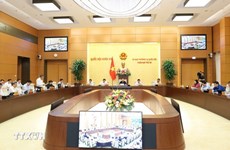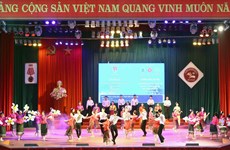Hanoi to spend over 3.8 million USD on developing new-style rural areas
 Illustrative image (Photo: VNA)
Illustrative image (Photo: VNA) Hanoi (VNA) - Hanoi is set to mobilise 89 trillion VND (over 3.8 million USD) for implementing the national target programme on building new-style rural areas in 2021-2025.
During 2016-2020, over 56.5 trillion VND (more than 2.4 billion USD) was spent on the programme, including over 4.8 trillion VND of non-State funds.
Hanoi has effectively deployed concentrated production areas in recent times, effectively exploiting the potential and strength of each region and promoting comprehensive agricultural development in a modern direction.
The average annual per capita income in rural areas has now increased to an estimated 55 million VND. Districts with a high annual average per capita income include Thach That (63 million VND), Dong Anh (60 million VND), and Hoai Duc (55 million VND).
Most homes in rural areas are solid and spacious. Healthcare and disease prevention efforts have made great progress, while all commune healthcare stations now have doctors.
All communes also have access to the internet.
Notably, the rate of poor households in rural areas has continually fallen over the years. It is expected that, by the end of 2020, the rate will be down to 0.5 percent, in line with new poverty standards.
There are no poor households in the three districts of Dong Anh, Gia Lam, and Hoai Duc.
Vietnam’s capital aims to build new-style rural areas in Thuong Tin district’s Hong Van commune and Dan Phuong district’s Dan Phuong commune.
The communes must meet four criteria under Decision No 691/ QD-TTg dated June 5, 2018, from the Prime Minister and seven criteria in Decision No 3745/QD-UBND dated July 11, 2019, from the municipal People’s Committee.
The fulfilment of the above-mentioned requirements is hoped to promote sustainable rural development in the capital towards improving the quality of the material and spiritual lives of rural people, widely applying science and technology in production, and preserving the unique cultural identities of each village.
According to the Director of the municipal Department of Agriculture and Rural Development, Chu Phu My, despite posting remarkable results in building new-style rural areas and progress in agricultural restructuring, these have not been commensurate with the potential and advantages the capital possesses.
Large-scale agricultural production remains limited, while agricultural growth is low, he said.
Investment attraction in the agricultural sector, in particular the application of advanced technologies, is still inadequate. Some districts still have high rates of poor households, such as Ba Vi (1.43 percent), My Duc (1.55 percent), and Thanh Oai (1.3 percent).
In order to achieve goals in poverty reduction and raise farmers’ incomes this year and in subsequent years, Hanoi will continue to pay attention to vocational training and to shifting the workforce from agriculture to other sectors.
The implementation of poverty reduction programmes will be accelerated, he added.
Attention will be also given to creating jobs for rural workers, restructuring crops and animals, supporting farmers in applying new technical advances, and promoting investment links.
Municipal authorities will also focus on expanding production in industrial clusters and craft villages in rural areas, and adopt policies to support the development of rural service systems, towards gradually accelerating the restructuring of the rural economy by increasing the proportion of industry and services and cutting that of agriculture.
The national target programme on building new-style rural areas was initiated by the Government in 2010 with the aim of developing rural regions. Criteria include the development of infrastructure, the improvement of production capacity, environmental protection, and the promotion of cultural values./.













